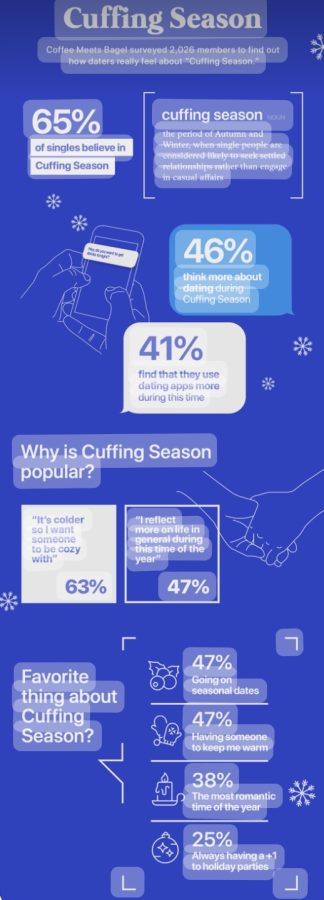Cuffing Season: are people really coupling up because it’s winter?
CoffeeMeetsBagel complied a survey illustrating the statistics of cuffing seasons existence.
January 27, 2022
You can feel it in the air, the snap when you step outside without a warm hand to hold, which sends you scurrying back inside for a pair of gloves. Cuffing season is coming. That feeling of winter that gets previously contented single people to start seeking shelter in the coziness of a committed relationship, at least until the weather begins to heat back up again.
According to the infamous post regarding the “cuffing season schedule,” surfacing throughout several social media platforms, each month reflects a new phase, with the season lasting from August to February. Kicking off with August being “scouting,” September is known as “drafting,” and the season picking up in pace during “tryouts” throughout October, “preseason” reigns through November. The official “cuffing season” starts during December, lasting through mid-January. Although you’d expect the schedule to finish after mid-January, some selective participants continue to the “playoffs” that last through the end of January to mid-February and finish with the “championship game” taking place on Valentine’s Day. Surely enough, it’s mentioned that this schedule ultimately fluctuates based upon feelings.
With social media obtaining a significant influence in our current society, the idealism of “cuffing season” has begun to intensify pressure, especially among teenagers and young adults. Much like modern culture, “cuffing season” primarily exists from a meaningless phrase to frankly suggest that it can suck to be single during winter. People tend to socialize less, which leads to more isolation. Shorter days can exacerbate feelings of loneliness, especially during a standard season of Seasonal Affective Disorder. In addition to including a cherry on top, the unwelcoming reminder of the holiday season haunts; another looming sense of spending the Christmas and New Year’s season alone. Traditional holiday activities such as baking holiday goods, going to Christmas light shows, building gingerbread houses, exchanging gifts, binge-watching classic Hallmark movies in matching pajamas, and attending parties provide ridicule around single people.
Surprisingly enough, studies show that levels of testosterone production peak around October. Marisa Cohen, a relationship scientist based in New York, completed an experiment that “cuffing season” definitely has an underdeveloped meaning. Cohen correlated with the University of Wroclaw in Poland and determined that “men find women’s bodies most attractive in the winter and less so during the warmer months.” In addition to the hormonal production, Cohen includes, “so that’s going to lead to people wanting to engage in more activity.” While Seasonal Affective Disorder also commonly occurs throughout the colder months, serotonin levels are decreased, and moods lower, which becoming romantically involved can boost an individual’s overall mood as there is a counteractant to biochemical changes present.
Although it seems unlikely that social media, hormonal production, or family would persuade someone to get into a relationship, it’s not entirely unconventional. Watching your family members bring their partner to holiday events and seeing friends advertise on social media their seasonal dates hinders a feeling of longing for lacking a partner. Keep in mind that although relationships are great experiences and can be fulfilled with enjoyment, don’t feel an obligation to be with someone based upon the time of year. Instead, look forward to not falling victim to the torture “cuffing season” endures.





